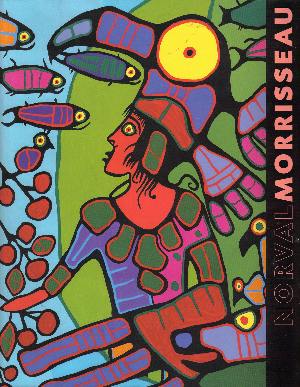 |
March 3, 2006Ojibway artist at the National
Gallery.
|
Norval Morrisseau, Ojibway artist and leader of the
Woodland school of native art has (until April 30th) the first solo
exhibition by an Anishnaabe artist in the 126-year history of Canada’s National
Gallery in Ottawa. The exhibition of 60 paintings, drawings, murals and
sculpture according to the press is “a complete triumph” for this “creative
genius”, and “great visionary shaman”. Woodland (including Morrisseau), Inuit
and West Coast native artists have been in group shows over the years at the
Gallery, but this is the first (long overdue) solo exhibition of a native
artist.
 |
Cover of
Norval Morrisseau exhibition catalogue. |
At the exhibition’s opening earlier this month Morrisseau,
in spite of Parkinson’s disease that has almost silenced his voice and his
painting, savoured the event. Morrisseau who was born near Port Arthur some 74
years ago started drawing 50 years ago as a teenager. I remember seeing his
first show at the Pollock Gallery in 1962 where all his paintings sold. He was
written up in Time magazine. His future looked bright but there were many ups
and downs leading to this current major exhibition 44 years later.
Norval, as the oldest son in his family, was raised by
his grandparents. His grandfather was intensely aware of his own native
spirituality and guided Norval, including a vision quest. He was sent to a
residential school where he was emotionally and sexually abused before coming
back to his community for a couple of years of education. Dropping out after
having learned to speak and write English, and having no art training he began
to draw with crayons and ballpoint pens. He was an intelligent and creative
loner who spent as much time as possible with adults listening and asking
questions.
There were many tough times in his life but he was lucky
to find several supporters who kept him on track to become one of Canada’s most
famous artists. In 1950 and 1956 he had serious health problems and spent
considerable time in hospital. In 1972 he was involved in a fire that burned a
large part of his body. He also had a serious drinking problem that put him on
the streets of Vancouver in the late 1980s selling some of his poorly drawn
sketches. His marriage broke up and he moved many times but seldom abandoned
his talent, ambition and vision.
His talent was discovered by the wife of a doctor in the
late 1950s in a mining community in northern Ontario where she saw his work for
sale in a store. Her husband was an artist and they bought some of his
paintings and brought him into their home to look at their extensive collection
of art books. Later Selwyn Dewdney an artist and anthropologist saw his work
and learned a lot from him about native life and taught him a lot. They met and
corresponded and Dewdney provided him with painting materials, instruction and
advice on moving from being a craftsperson to being a professional artist. Jack
Pollock, a Toronto Gallery owner met him while on a northern trip and was
overwhelmed by his work. He held Norval’s first exhibition in 1962 in Toronto
and all of his paintings sold.
His unique style developed and he became the leader of
the new Ontario Woodland or Anishnaabe school of art. He included many animals
and much native mythology in his work. He showed the inside of his figures in
an X-ray style that was quite powerful. His technique of putting black lines
around sections of his figures, like lead around stained glass was unique. His
heightened use of colour was another effective and recognizable characteristic
as was his brilliant use of space.
In 1967 he was asked to do a mural for Expo ’67 and the
respect heightened his recognition. He was a highly productive artist who also
did silk screen copies of his work in the hundreds. (There are five of his
signed and numbered prints in the North Bay Public Library outside the
Children’s section). Over the years he had many successful exhibitions. He was
criticized by native people for sharing their vision and mythology outside the
native community and at various times by non-natives for being too productive
and illustrative and getting away from his roots.
Over the years he received The Order of Canada and
honorary doctorates from McMaster and McGill and other accolades. Books and
articles were written about him and the native community honoured him. During
his crisis on the streets of Vancouver he met Gabe Vadas who took him into his
family and supported his artistic endeavours until Parkinson’s put him into a
care facility, into a wheel chair and curtailed his painting. A crisis of fake
Morrisseau’s is currently being resolved as his life shortens and the potential
value of his paintings rises.
His story is much more detailed than this space allows.
The stunning catalogue for the exhibition with three excellent essays is
available at the National Gallery (www.national.gallery.ca) at 613-990-0962
($55.00) and the show runs until April 30 when it will move to the McMichael
Gallery in Kleinberg on September 30. This is a great opportunity to see one of
Canada’s great painters – a man of intelligence, drive, creativity and insight
of the highest order.
PS: For more information see
Norval
Morrisseau's principal gallery's webpage: http://www.kinsmanrobinson.com/dynamic/artist.asp?ArtistID=11
Coincidentally the Royal Ontario Museum has recently
opened its new Gallery of Canada: First Peoples, which displays an incredible
array of native historical artifacts.
Heritage Perspective Home Page
| 
![]() Past
Forward is now on Facebook "LIKE" us to keep in touch
Past
Forward is now on Facebook "LIKE" us to keep in touch